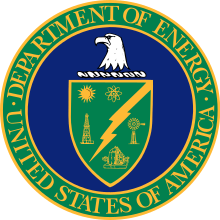University of Missouri Research Reactor Center
The University of Missouri Research Reactor Center (MURR) is home to a tank-type nuclear research reactor that serves the University of Missouri's Nuclear Science and Engineering Institute (NSEI)[1] in Columbia. As of March 2012, the MURR is the highest power university research reactor in the U.S. at 10 megawatt thermal output. The fuel is highly enriched uranium.[2]
History and overview
In 1959, University President Elmer Ellis proposed a research reactor, understanding that the many fields of research to benefit from nuclear science "are a part of the University of Missouri's educational responsibilities to our youth and to all our citizens". The MURR began operation October 13, 1966 about one mile (1.6 km) southwest of the university's main campus and the city's main business district. The supplier of construction services was General Electric. In 1970, MURR scientist Dr. George Leddicotte gave the first courtroom testimony on murder trial evidence using neutron activation analysis. Four years later MURR began operating at 10 MW, making it the highest powered U.S. university reactor. Ir-192 was first produced at MURR for fighting breast cancer in 1976. The first small angle neutron scattering (SANS) spectrometer in the U.S. was installed in 1980. In 1986 the first experiments were performed that led to developing Quadramet and TheraSphere, which were later approved by the U.S. Food and Drug Administration (FDA) for helping fight against bone and liver cancer respectively.[3]
Since 2000, systematic upgrades, renovation, and renewal to MURR facilities and instrumentation in preparation for the next 20 years of licensed operation have taken place. In 2002, a 6,000 sq ft (560 m2) building addition opened the way for expansion into cGMP scaleup of isotopes. Groundbreaking began in 2006 on a 25,000 sq ft (2,300 m2) addition to house laboratories, classrooms and offices to advance interdisciplinary research, education and treatment of patients. As of March 2012, MURR supports research of approximately 400 faculty and 150 graduate students representing more than 180 departments from more than 100 international universities and around 40 federal and industrial labs every year. A cyclotron that will supply mid-Missouri with isotopes for PET imaging and support additional research, development, and clinical trials has been installed.[4]
Licensing
Some important reactor events are summarized here.
| Year | Change |
|---|---|
| 1966 | Commenced operation |
| 1974 | 100% power upgrade |
| 1977 | More than 50% increase in operating hours, allowing reactor to maintain over 150 hours per week of operation |
| 2001 | Original Nuclear Regulatory Commission license expired |
| 2026 | New 20-year license to expire, at which point either decommissioning or additional license extension would occur[3] |
MURR began the process to renew its operating license in 2006, and responded to requests for additional information in 2009 and 2010.[5] Once approval has been granted (MURR is still going through the process as of April 2012), the reactor will be licensed to operate until 2026.[2]
Research
The MURR contributes to research in boron neutron capture therapy, neutron scattering and neutron interferometry, neutron transmutation doping of semiconductor materials, use of radioisotopes for imaging and treatment of cancer, epidemiology, and archaeology, along with many others.
Archaeometry Laboratory
The Archaeometry Laboratory at MURR has been funded by National Science Foundation (NSF) since 1988. The neutron activation capabilities are used to characterize over 30 major, minor, and trace elements in archaeological and geological materials.[6] In addition to neutron activation, the laboratory maintains and operates several X-ray fluorescence spectrometers, multiple ICP-mass spectrometers, and a multi-collector ICP-MS for isotope-ratio mass spectrometry. The laboratory is one of only a handful of facilities in the world to have access to all of these analytical methods.
Data generated by the laboratory are typically used by archaeologists to study issues relating to provenance (geological source) that facilitate understanding of trade and exchange in prehistory. The laboratory also handles analyses of geological materials in support of geology, soil science, and other environmental sciences.[7]
Neutron scattering
The neutron scattering program at MURR has a long and productive history. On the one hand, many prominent scientists have graduated from this program and benefited from the in depth, hands on experience afforded by MURR's unique combination of high neutron flux and proximity to a flagship campus (the University of Missouri). On the other hand, cutting edge research continues on the four active neutron scattering instruments of MURR's beamport floor: Triax (a triple-axis spectrometer), NR/GANS (a neutron reflectometer with spin-polarized capability), 2X-C (a multi-detector diffractometer), and PSD (a high-resolution diffractometer with position sensitive detectors). Furthermore, the landmark neutron interferometry experiments performed here have played an important role in opening the field of experimental quantum mechanics.
References
- Perez, Pedro B. (2000). "University Research Reactors: Contributing to the National Scientific and Engineering Infrastructure from 1953 to 2000 and Beyond". National Organization of Test, Research and Training Reactors.
- ↑ "Nuclear Science and Engineering Institute, Mizzou". Nsei.missouri.edu. 2012-01-18. Retrieved 2015-11-09.
- 1 2 "MU Research Reactor - Operations". Murr.missouri.edu. Retrieved 2015-11-09.
- 1 2 Archived July 10, 2007, at the Wayback Machine.
- ↑ Archived February 14, 2007, at the Wayback Machine.
- ↑ Ralph Butler. "University of Missouri Research Reactor (MURR) License Renewal Experience" (PDF). Nrc.gov. Retrieved 2015-11-09.
- ↑ "The Archaeometry Laboratory at the University of Missouri Research Reactor". Archaeometry.missouri.edu. Retrieved 2015-11-09.
- ↑ "Applications of NAA". Archaeometry.missouri.edu. Retrieved 2015-11-09.
External links
- Official website
- ABC's Radioactive Roadtrip Security Review of the Research Reactor Center
- MURR's Neutron Scattering program
- MURR Archaeometry Laboratory
Coordinates: 38°55′54″N 92°20′31″W / 38.93169°N 92.34188°W
